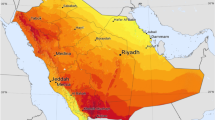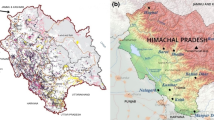Abstract
The article deals with optimizing tilt angles of photovoltaic panels for fixed and manually adjusted solar photovoltaic system with due south-facing orientation to maximize the output of solar electricity in Gansu province, northwest China. There are three models by Liu and Jordan, Hay and Kliein and Theilacker selected to calculate the seasonal and yearly optimum tilt angles of solar panels through Matlab programs on seven sites in Gansu province. Meanwhile, the outdoor experiment was conducted to measure the yearly sum of global solar irradiance at different tilt angles. The study found that (1) the calculated yearly optimum tilt angles by three models are close among each other especially between Liu and Jordan’s and Klein and Theilacker’s models; (2) the annual optimum tilt angles of solar panels for fixed installation could be set at model’s angle for higher latitude sites with most-rich solar energy, and latitude angle for lower latitude sites with medium-rich and less-rich solar resources; (3) the seasonal optimum tilt angles should be set at average models’ angle for manual adjustment of photovoltaic system across a year; (4) for all sites, the model’s angle could be selected for a photovoltaic system when considering limitation of land-use area.




Similar content being viewed by others
REFERENCES
Hua, Y.P., Oliphant, M., and Hu, E.J., Development of renewable energy in Australia and China: A comparison of policies and status, Renewable Energy, 2016, vol. 85, pp. 1044–1051.
Renewable energy policy network for the 21st century, Renewables 2018 Global Status Report, REN21, 2018.
Daus, Y.V., Yudaev, I.V., and Stepanchuk, G.V., Reducing the costs of paying for consumed electric energy by utilizing solar energy, Appl. Sol. Energy, 2018, vol. 54, no. 2, pp. 139–143.
Nann, S., Potentials for tracking photovoltaic systems and V-troughs in moderate climates, Sol. Energy, 1990, vol. 45, no. 6, pp. 385–393.
Duffie, J.A. and Beckman, W.A., Solar Engineering of Thermal Processes, New York: Wiley, 1991, 2nd ed.
Lunde, P.J., Solar Thermal Engineering, New York: Wiley, 1980.
Guo, M., Zang, H.X., Gao., S.Y., Chen, T.J., Xiao, J., Cheng, L.X., Wei, Z.N., and Sun, G.Q., Optimal tilt angle and orientation of photovoltaic modules using HS algorithm in different climates of China, Appl. Sci., 2017, vol. 7, id. 1028. https://doi.org/10.3390/app7101028
Bakirci, K., General models for optimum tilt angles of solar panels: Turkey case study, Renewable Sustainable Energy Rev., 2012, vol. 16, pp. 6149–6159.
Benghanem, M., Optimization of tilt angle for solar panels: Case study for Madinah, Saudi Arabia, Appl. Energy, 2011, vol. 88, pp. 1427–1433.
Herrera-Romero, J.V., Colorado-Garrido, D., Escalante Soberanis, M.A., and Flota-Banuelos, M., RETRACTED: Estimation of the optimum tilt angle of solar collectors in Coatzacoalcos, Veracruz, Renewable Energy, 2019, vol. 153, pp. 615–623.
Kuvshinov, V.V., Abd Ali, L.M., Kakushina, E.G., et al., Studies of the PV array characteristics with changing array surface irradiance, Appl. Sol. Energy, 2019, vol. 55, no. 4, pp. 223–228.
Abdallah, R., Juaidi, A., Abdel-Fattah, S., and Manzano-Agugliaro, F., Estimating the optimum tilt angles for south-facing surfaces in Palestine, Energies, 2020, vol. 13, no. 3, p. 623. https://doi.org/10.3390/en13030623
Nfaoui, M. and El-Hami, K., Extracting the maximum energy from solar panels, Energy Rep., 2018, vol. 4, pp. 536–545.
Ramadan, A. and Elistratov, V., Techno-economic evaluation of a grid-connected solar PV plant in Syria, Appl. Sol. Energy, 2019, vol. 55, no. 3, pp. 174–188.
Garni, H.Z.A., Awasthi, A., and Wright, D., Optimal orientation angles for maximizing energy yield for solar PV in Saudi Arabia, Renewable Energy, 2019, vol. 133, pp. 538–550.
The status of grid-connected operation of photovoltaic in 2019. National Energy Administration (NEA), 2019. http://www.nea.gov.cn/2020-02/28/c_138827923.htm. Accessed July 1, 2020.
Liu, B.Y.H. and Jordan, R.C., Daily insolation on surfaces tilted toward the equator, ASHRAE Trans., 1962, pp. 526–541.
Hay, J.E., Calculation of monthly mean solar radiation for horizontal and inclined surface, Sol. Energy, 1979, vol. 23, no. 4, pp. 301–307.
Hay, J.E., Calculating solar radiation for inclined surfaces: Practical approaches, Renewable Energy, 1993, vol. 3, nos. 4–5, pp. 373–380.
Klient, S.A. and Theilacker, J.C., An algorithm for calculating monthly-average radiation on inclined surfaces, J. Sol. Energy Eng., 1981, vol. 103, pp. 29–33.
Wang, X.W. and Yi, J., Research on the sustainable development of Gansu’s ecological economy based on ecological footprint, J. Gansu Soc. Sci., 2010, vol. 3, pp. 206–208.
Klein, S.A., Calculation of monthly average insolation on tilted surfaces, Sol. Energy, 1977, vol. 19, no. 4, pp. 325–329.
Shukla, K.N., Rangnekar, S., and Sudhakar, K., Comparative study of isotropic and anisotropic sky models to estimate solar radiation incident on tilted surface: A case study for Bhopal, India. Energy Rep., 2015, vol. 1, pp. 96–103.
Zhao, D.L., Yang, Z.Q., Zou, H., Qu, H.B., and Cao, H.H., Study on economically optimal tilt angle of photovoltaic power generation during the life cycle, Sol. Energy, 2017, vol. 12, pp. 45–51.
Tang, R.S. and Wu, T., Optimal tilt-angle for solar collectors used in China, App. Energy, 2004, vol. 79, pp. 239–248.
Jacobson, M.Z. and Jadhav, V., World estimates of PV optimal tilt angles and ratios of sunlight incident upon tilted and tracked PV panels relative to horizontal panels, Sol. Energy, 2018, vol. 169, pp. 55–66.
Funding
This work was under the support of International Clean Energy Talent Program by China’s Scholarship Council and it was also funded by the Key R&D Project in Gansu Natural Energy Research Institute (no. 2019YF-03).
Author information
Authors and Affiliations
Corresponding author
About this article
Cite this article
Yaping Hua, He, W. & Liu, P. Optimum Tilt Angles of Solar Panels: A Case Study for Gansu Province, Northwest China. Appl. Sol. Energy 56, 388–396 (2020). https://doi.org/10.3103/S0003701X20050060
Received:
Revised:
Accepted:
Published:
Issue Date:
DOI: https://doi.org/10.3103/S0003701X20050060




